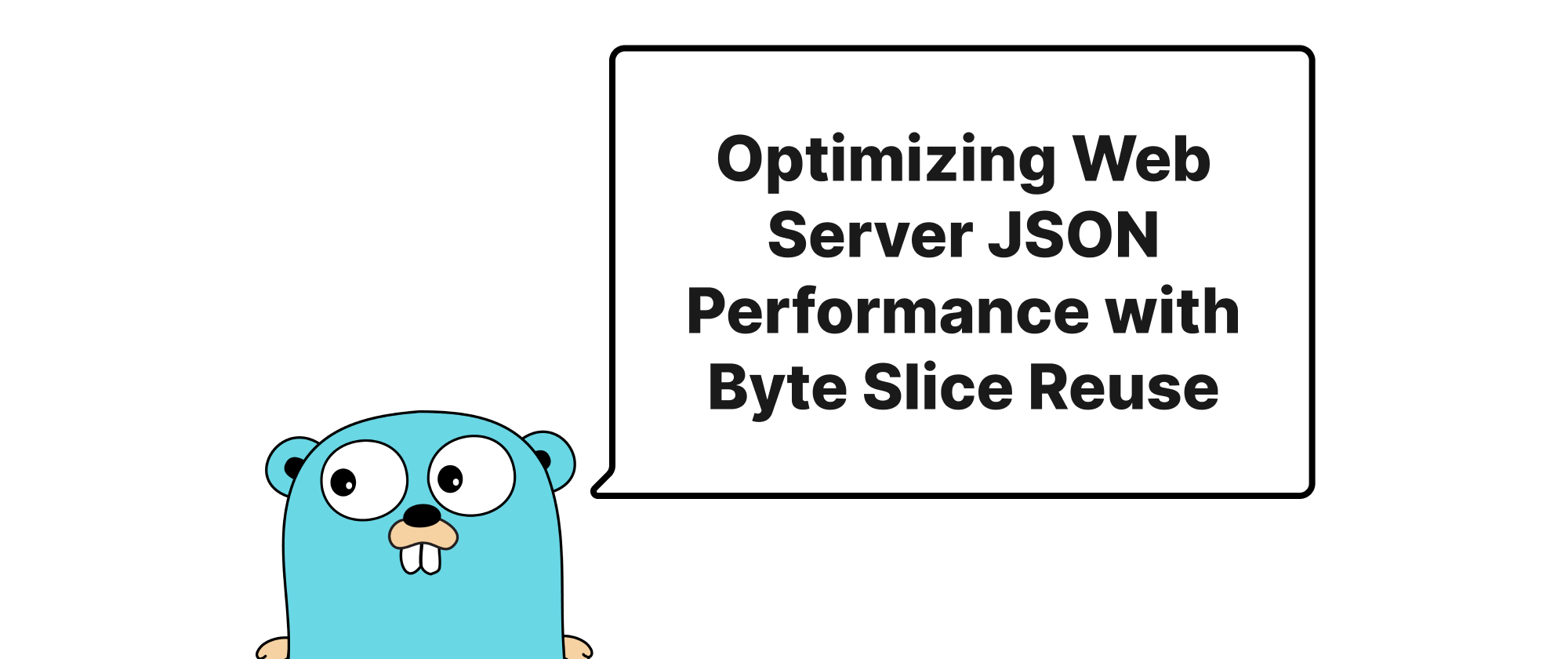Optimizing Web Server JSON Performance with Byte Slice Reuse
Takashi Yamamoto
Infrastructure Engineer · Leapcell

Introduction
In the world of high-performance web servers, every millisecond and every byte of memory counts. Go, with its excellent concurrency model and built-in tooling, is a popular choice for building scalable web services. However, even in Go, seemingly mundane tasks like JSON encoding and decoding can become bottlenecks under heavy load. A common pattern in web applications is the frequent allocation and deallocation of []byte slices – particularly when handling request bodies and response payloads. These constant allocations put pressure on the Garbage Collector (GC), leading to increased latency and reduced throughput. This article delves into how we can effectively reuse []byte slices using Go's sync.Pool to dramatically optimize JSON serialization and deserialization performance in web servers, ultimately leading to a more efficient and responsive application.
Core Concepts and Implementation
Before diving into the optimization techniques, let's briefly define some core concepts that are instrumental to understanding this discussion.
[]byte Slice
A []byte in Go is a slice of bytes. It's a dynamic data structure that points to an underlying array, representing a contiguous sequence of bytes. They are heavily used in I/O operations, network communication, and data manipulation, including JSON processing.
sync.Pool
sync.Pool is a Go standard library type designed to manage a pool of temporary objects that can be reused. It's not a general-purpose object cache; rather, it's intended for items that are allocated and deallocated frequently, where the cost of allocation (and subsequent garbage collection) outweighs the cost of acquiring and releasing from the pool. sync.Pool helps reduce allocation pressure and GC overhead by allowing objects to be retrieved from the pool, used, and then returned for future reuse, rather than being discarded and re-created.
JSON Encoding and Decoding
JSON (JavaScript Object Notation) is a lightweight data-interchange format. In Go, the encoding/json package provides functions to marshal (encode) Go data structures into JSON []byte and unmarshal (decode) JSON []byte into Go data structures. These operations involve creating and manipulating []byte slices to hold the JSON representation.
The Performance Challenge
Consider a typical web server. For every incoming request, it might read the request body (often JSON) into a []byte, unmarshal it, process the data, marshal a response into another []byte, and then write it back. If a server handles thousands of requests per second, this translates to thousands of []byte allocations and deallocations every second, creating significant GC pressure.
Optimizing with sync.Pool
The core idea is to replace the constant allocation of new []byte slices with acquiring them from a pool and returning them after use. Let's look at how we can implement this.
First, we'll define a sync.Pool for our byte slices. It's crucial to provide a New field that tells the pool how to create a new object if none are available. We'll pre-allocate a reasonable capacity, say 1KB, as a starting point.
package main import ( "encoding/json" "net/http" "sync" "bytes" // For bytes.Buffer ) // Define a pool of []byte slices var bytePool = sync.Pool{ New: func() interface{} { // Initialize the []byte with a sensible default capacity // This capacity should be chosen based on typical JSON payload sizes. // If payloads are often larger, the slice will grow, but frequent small allocations are avoided. return make([]byte, 0, 1024) }, } // Example Request/Response structures type RequestPayload struct { Name string `json:"name"` Age int `json:"age"` } type ResponsePayload struct { Message string `json:"message"` Status string `json:"status"` } // Handler function demonstrating pooled byte slice usage for decoding and encoding func jsonHandler(w http.ResponseWriter, r *http.Request) { // 1. Acquire []byte for reading request body reqBuf := bytePool.Get().([]byte) // Important: Reset the slice's length but preserve capacity for reuse reqBuf = reqBuf[:0] defer func() { // Reset the slice before returning to the pool to prevent memory leaks/stale data. // Note: No need to nil out contents for []byte if we always reset length to 0. bytePool.Put(reqBuf) }() // Read the request body into the pooled buffer // A bytes.Buffer can be used for more efficient reading into a dynamically growing slice. // We'll borrow a bytes.Buffer from a pool if possible. buf := new(bytes.Buffer) // For simplicity, new here. In production, pool bytes.Buffer as well. _, err := buf.ReadFrom(r.Body) if err != nil { http.Error(w, "Failed to read request body", http.StatusInternalServerError) return } // Copy contents from bytes.Buffer to our pooled reqBuf // This might seem like an extra copy, but ReadFrom directly into reqBuf could be complex // if reqBuf needs to grow beyond its initial capacity allocated by the pool. // For small, predictable sizes, direct read might be possible with checks. reqBuf = append(reqBuf, buf.Bytes()...) var payload RequestPayload err = json.Unmarshal(reqBuf, &payload) if err != nil { http.Error(w, "Failed to decode request JSON", http.StatusBadRequest) return } // 2. Process payload response := ResponsePayload{ Message: "Hello, " + payload.Name, Status: "success", } // 3. Acquire []byte for encoding response resBuf := bytePool.Get().([]byte) resBuf = resBuf[:0] // Reset length defer func() { bytePool.Put(resBuf) }() encoded, err := json.Marshal(&response) if err != nil { http.Error(w, "Failed to encode response JSON", http.StatusInternalServerError) return } // Copy encoded bytes to our pooled buffer (resBuf) resBuf = append(resBuf, encoded...) w.Header().Set("Content-Type", "application/json") w.Write(resBuf) } func main() { http.HandleFunc("/greet", jsonHandler) http.ListenAndServe(":8080", nil) }
In the example above, we create a bytePool that provides []byte slices. When Get() is called, it either retrieves an existing slice from the pool or creates a new one with a default capacity of 1024 bytes. Before returning the slice to the pool with Put(), we ensure its length is reset (resBuf = resBuf[:0]). This is crucial to prevent accumulated data from affecting future uses and to allow the slice to be used as a fresh buffer. The capacity, however, remains, allowing the slice to grow back to its previous (potentially larger) size without re-allocating the underlying array.
Considerations and Best Practices
- Capacity Choice: The initial capacity in
Newfunction (1024in our example) is important. If typical payloads are much larger, the slice will repeatedly grow, potentially negating some benefits. If payloads are much smaller, we might be holding onto unnecessarily large slices. Profiling your application to understand average and maximum payload sizes is key. - Resetting before
Put: Always reset the length of the slice (e.g.,s = s[:0]) before callingPut. This ensures that subsequentGetcalls receive a "clean" slice ready for use. Failing to do so can lead to subtle bugs where old data is unintentionally included or accessed. bytes.Bufferandsync.Pool: For more complex I/O patterns, you might even poolbytes.Bufferinstances, which internally manage[]byteslices. This can be more convenient for reading fromio.Readersources directly.- Not for Long-Lived Objects:
sync.Poolis for short-lived, temporary objects. Items in the pool can be evicted at any time by the runtime, especially during garbage collection cycles. Do not store objects insync.Poolif you need them to persist indefinitely or expect a certain number of objects to always be available.
Performance Impact
The primary benefit of this approach is a significant reduction in memory allocations. Less allocation means less work for the Garbage Collector, resulting in:
- Lower GC Latency: Fewer stop-the-world pauses (or shorter ones) from the GC.
- Reduced Memory Footprint: The application reuses memory instead of requesting new chunks from the OS repeatedly.
- Improved Throughput: More CPU cycles are spent on application logic and less on memory management.
Benchmarks often show substantial improvements, especially under high concurrency, with reductions in CPU usage and average request latency.
Conclusion
By strategically employing sync.Pool to manage []byte slices for JSON encoding and decoding, Go web servers can achieve a significant performance uplift. This technique minimizes memory allocations, thereby reducing garbage collection pressure and leading to lower latency, higher throughput, and a more efficient use of system resources. When dealing with high-volume services, thoughtful byte slice reuse transforms a potential bottleneck into a highly optimized component of your application.


